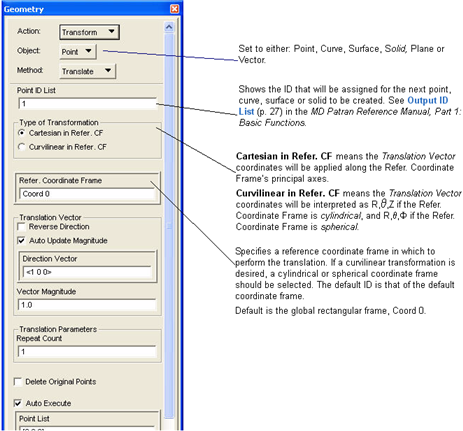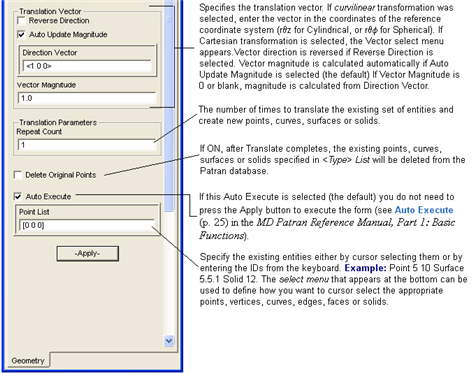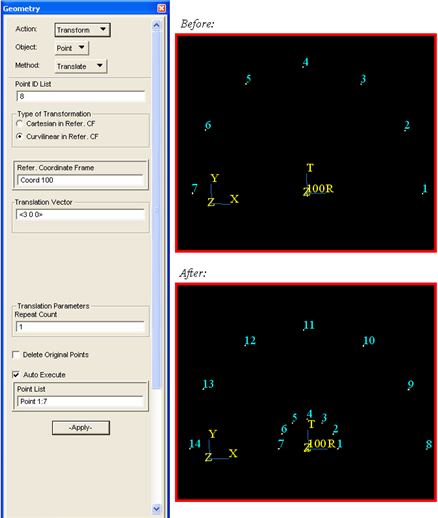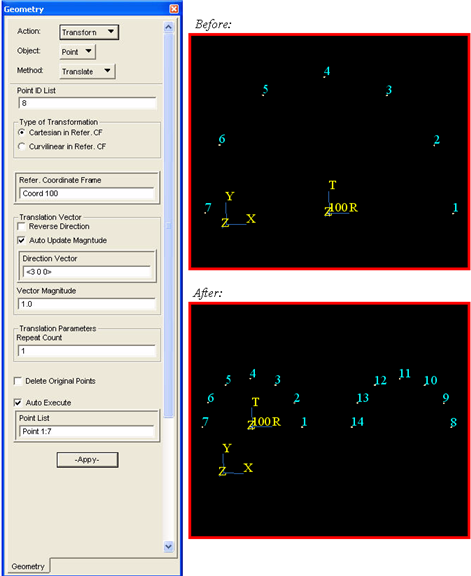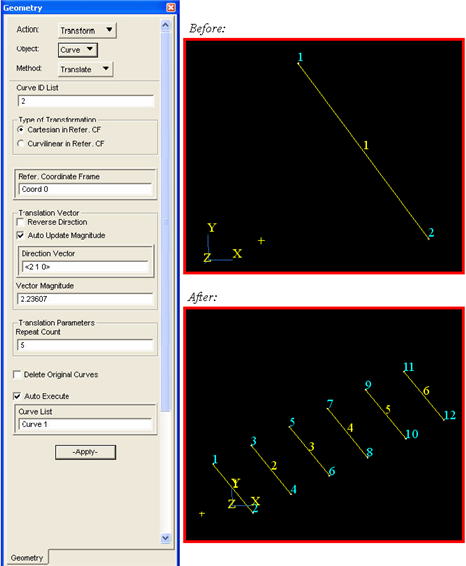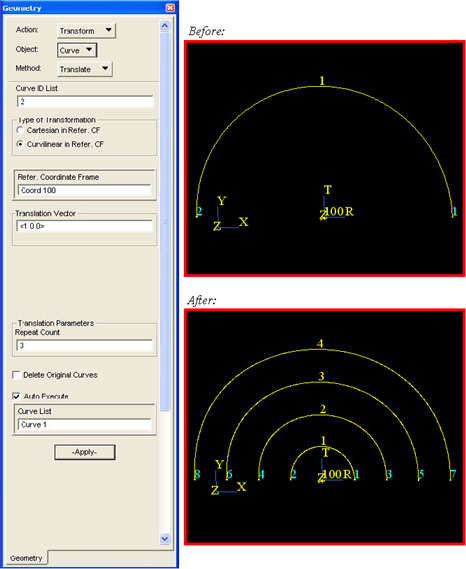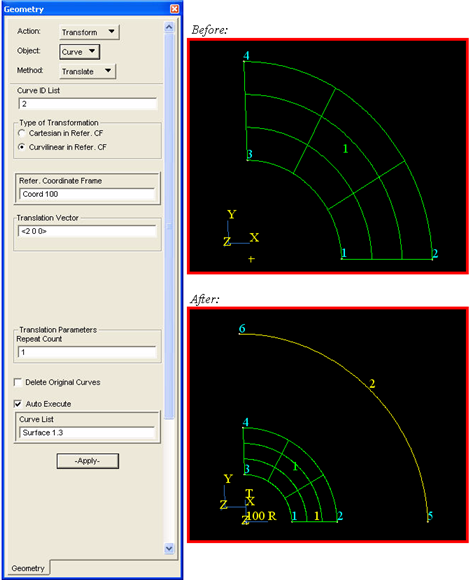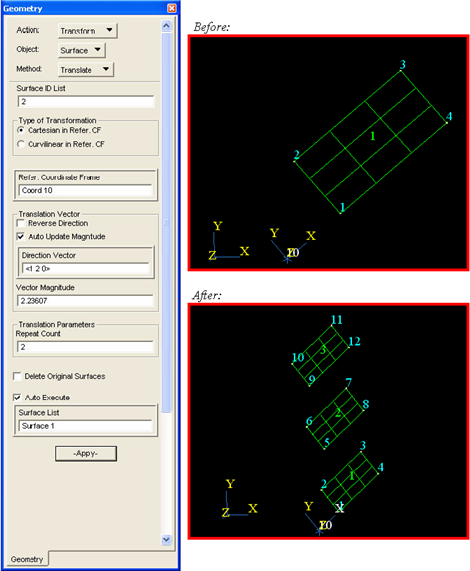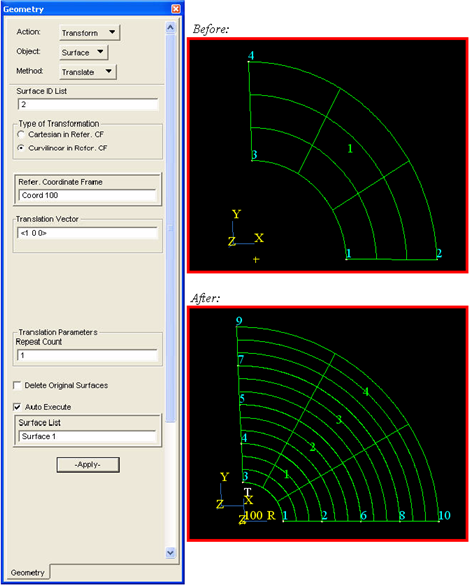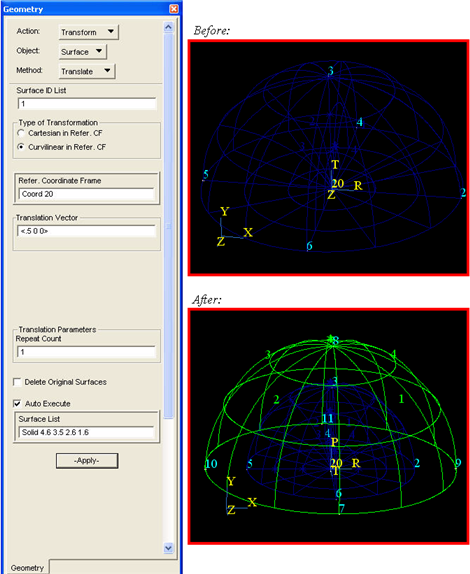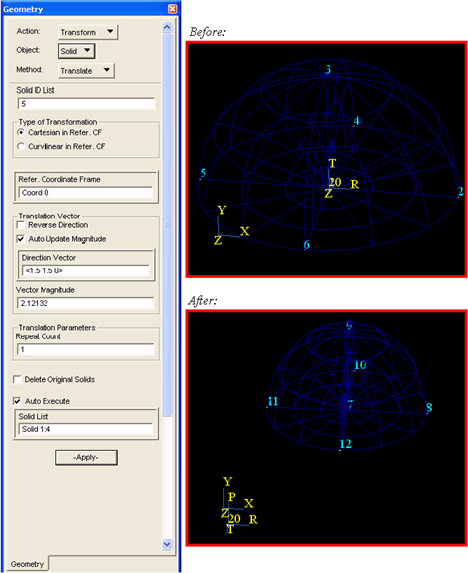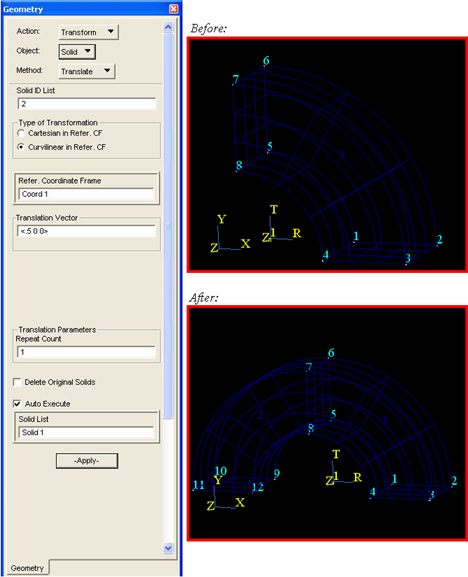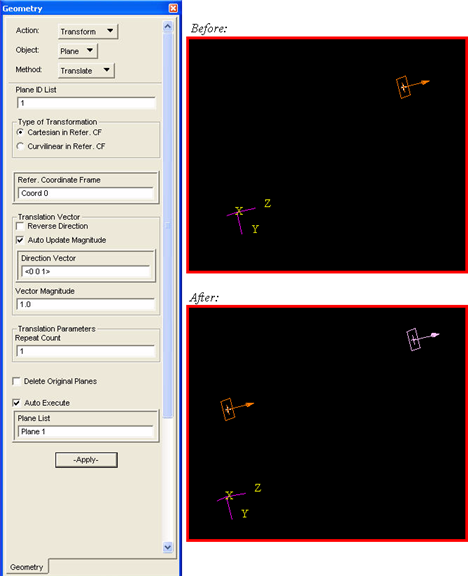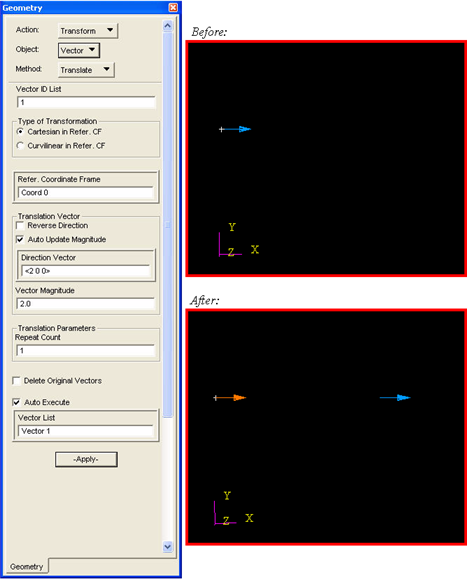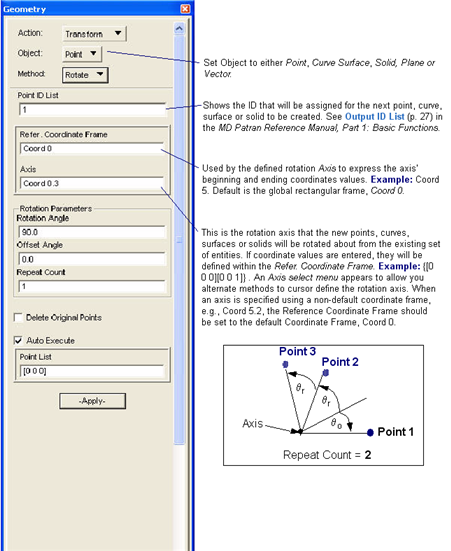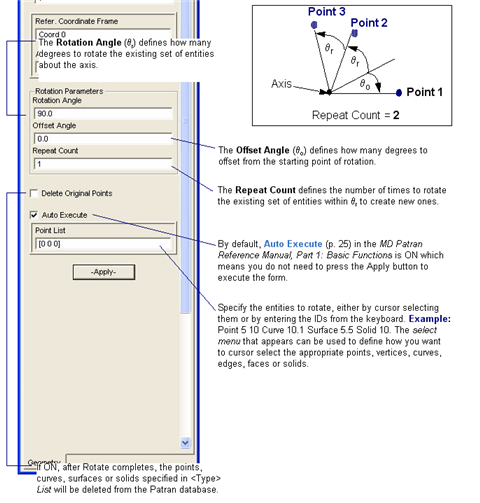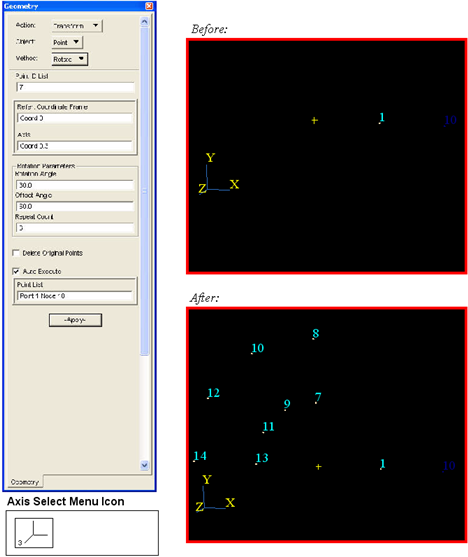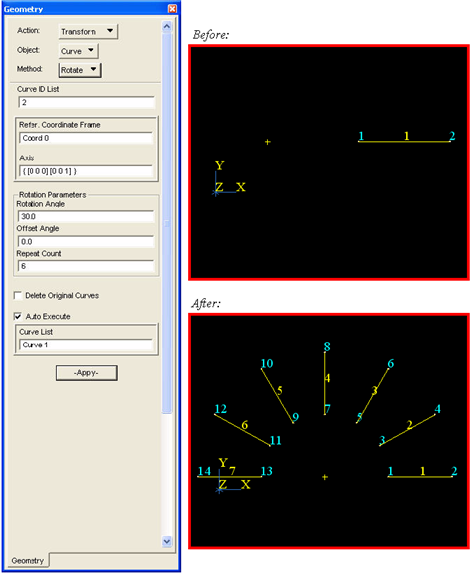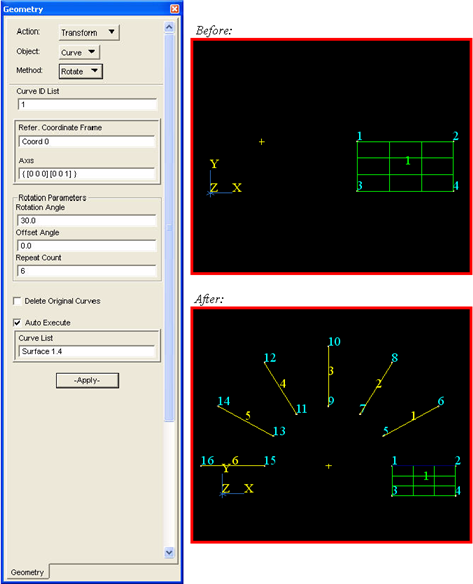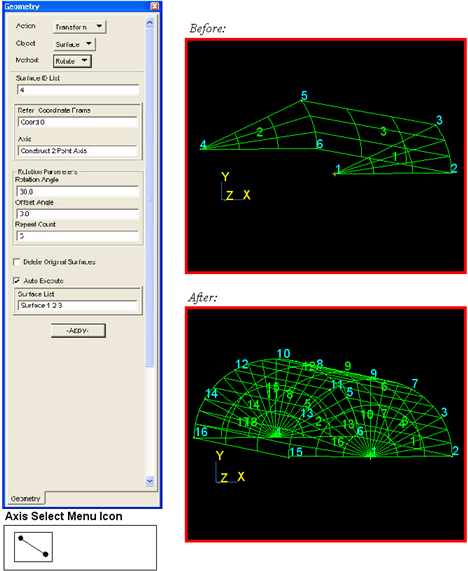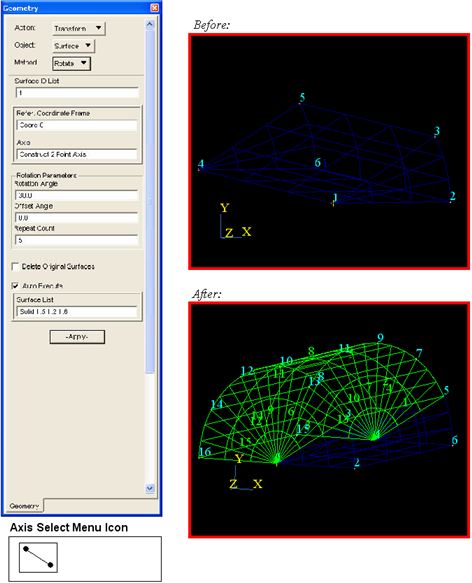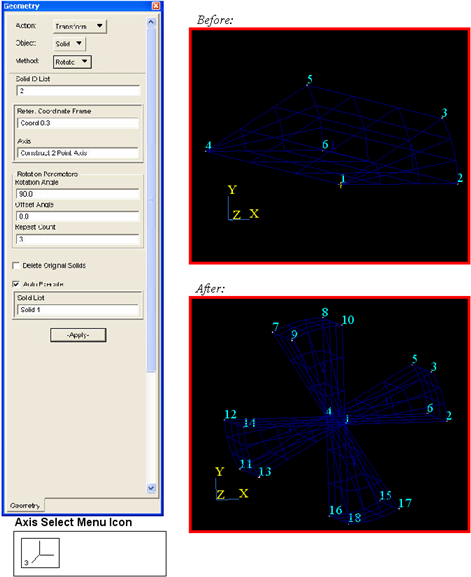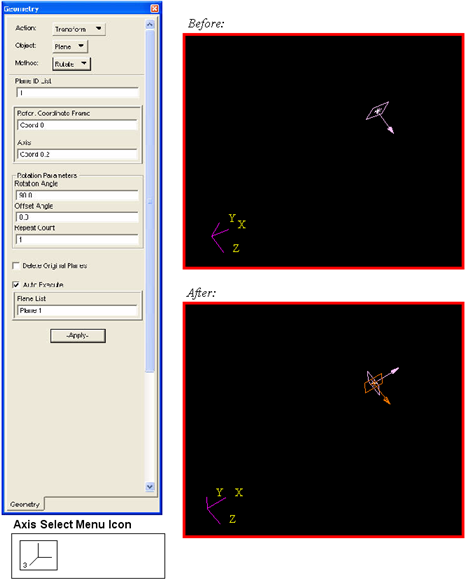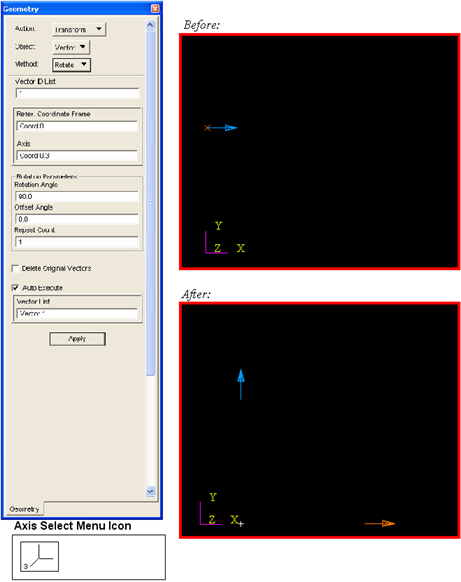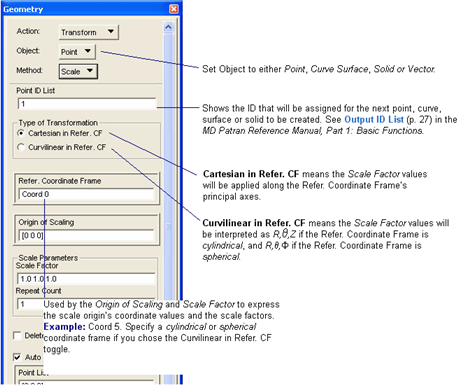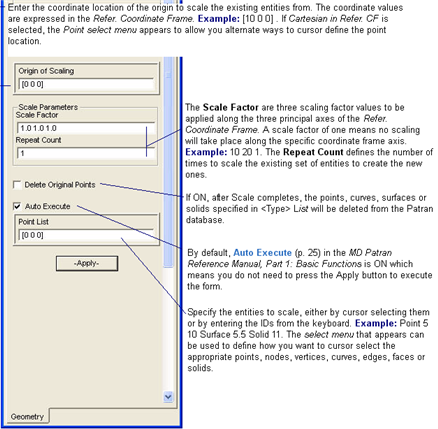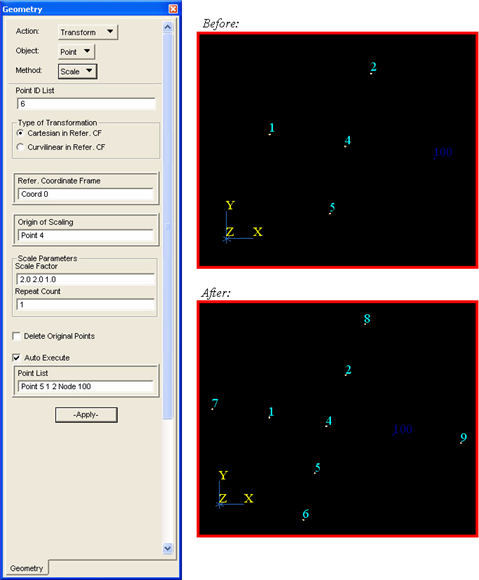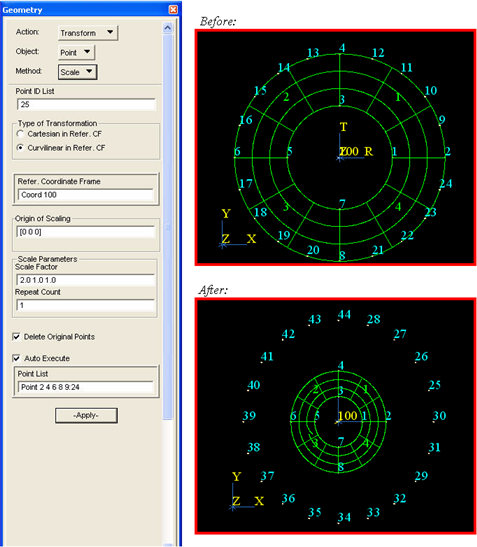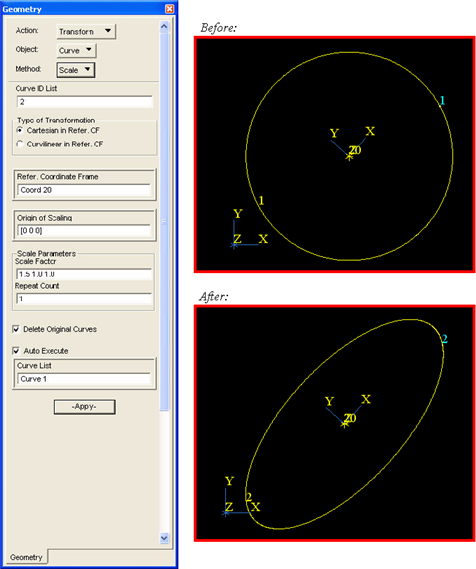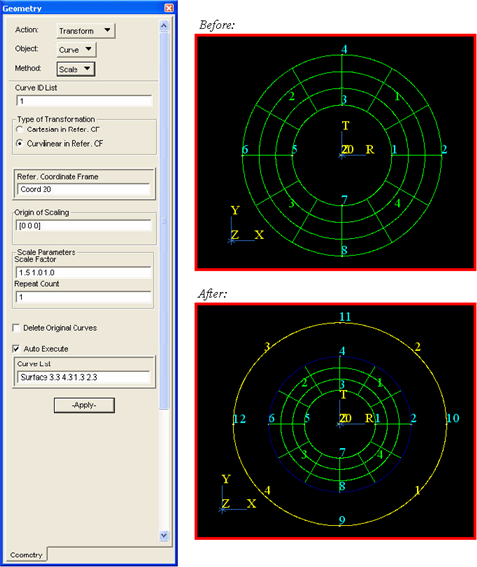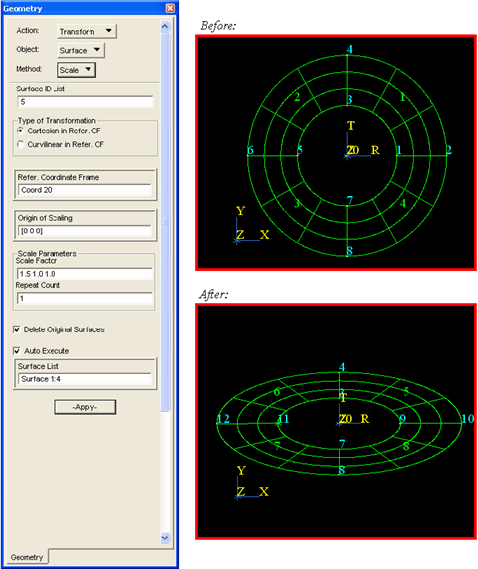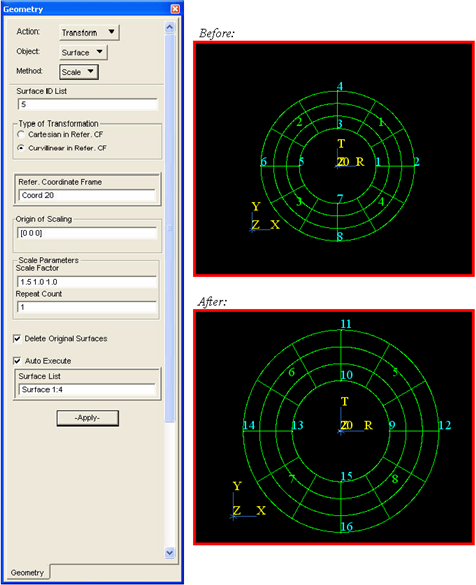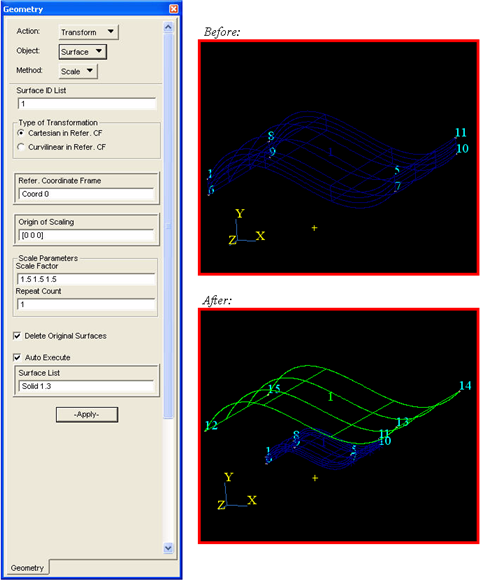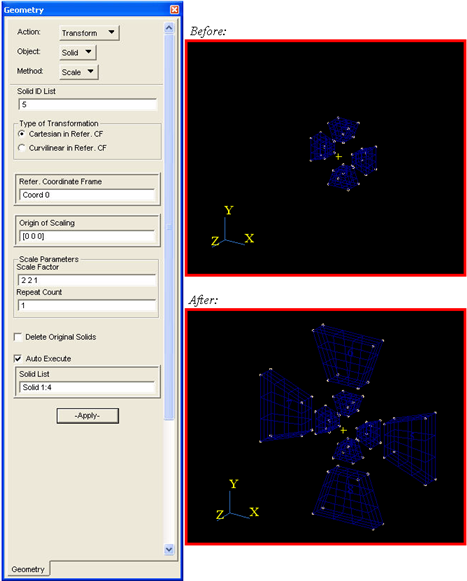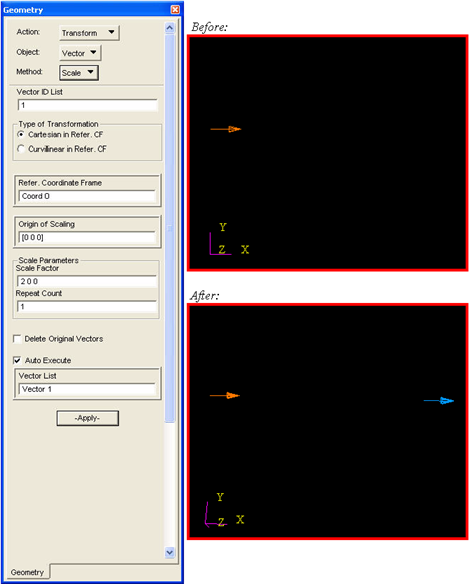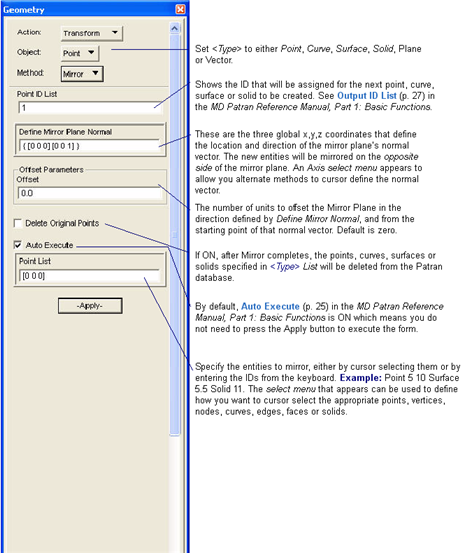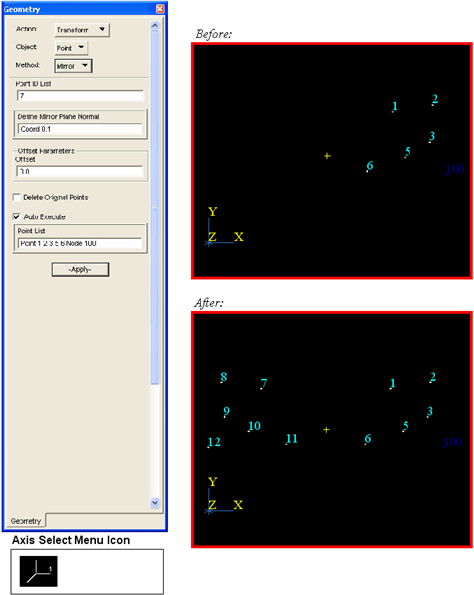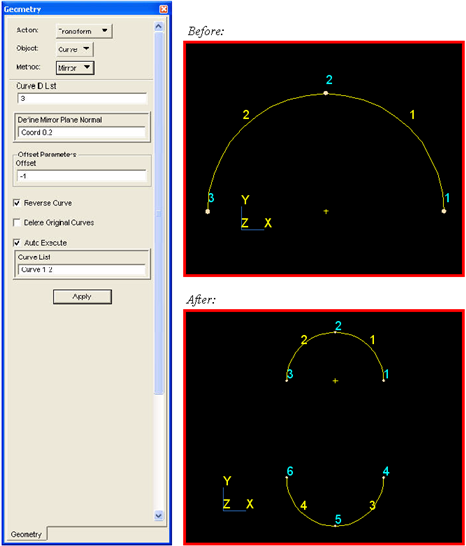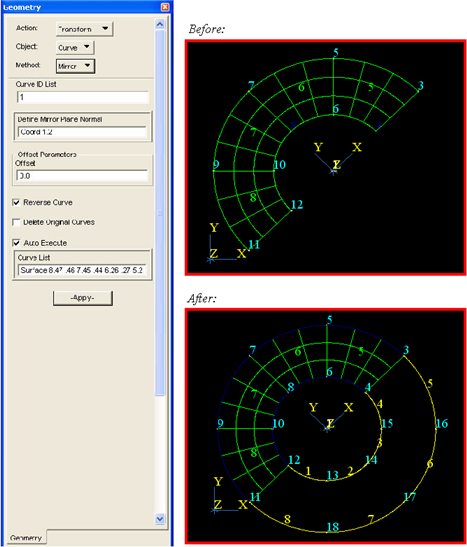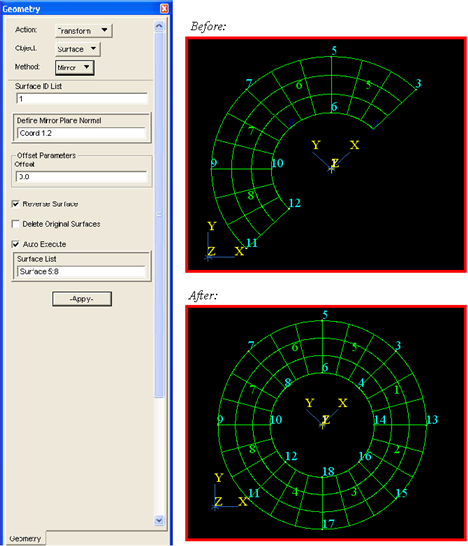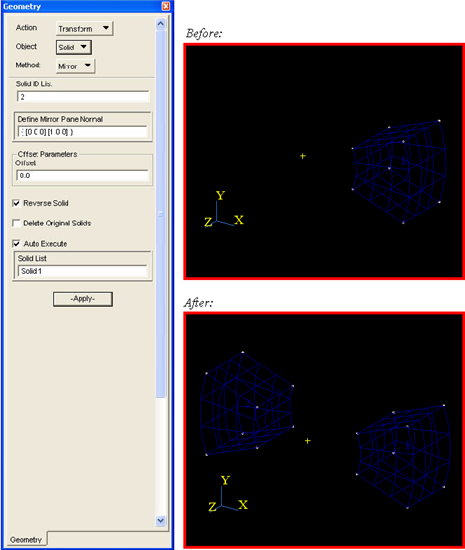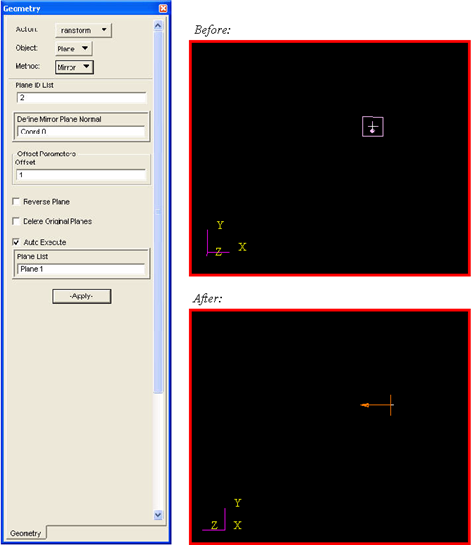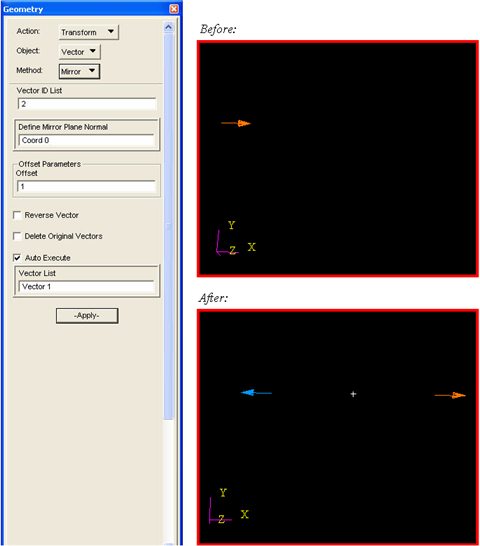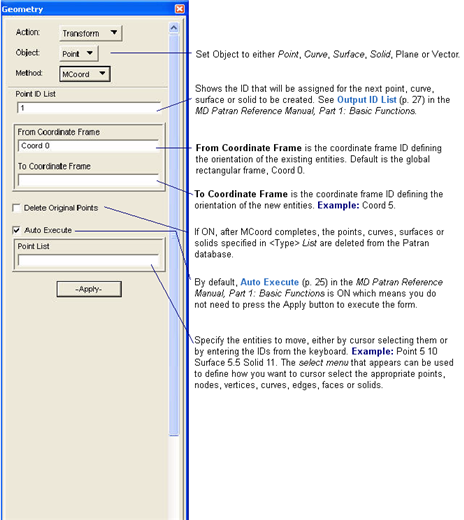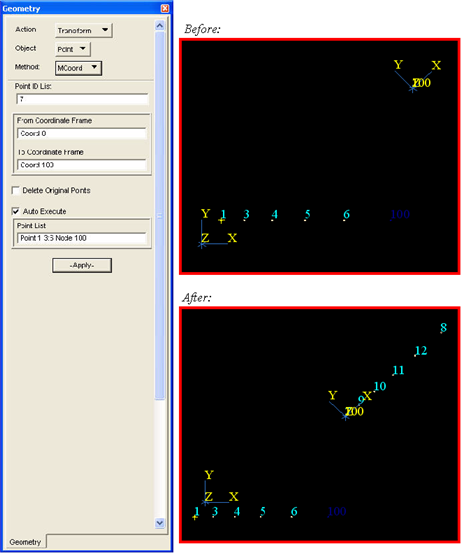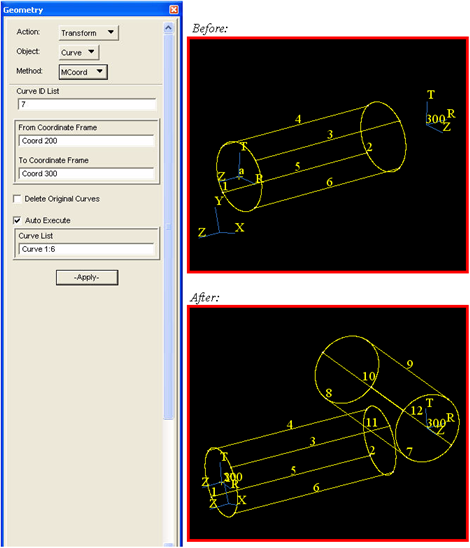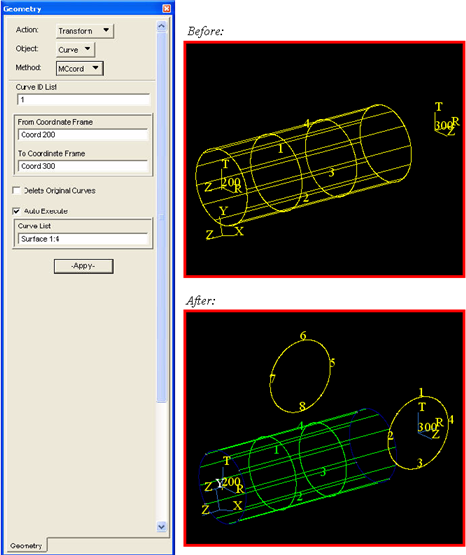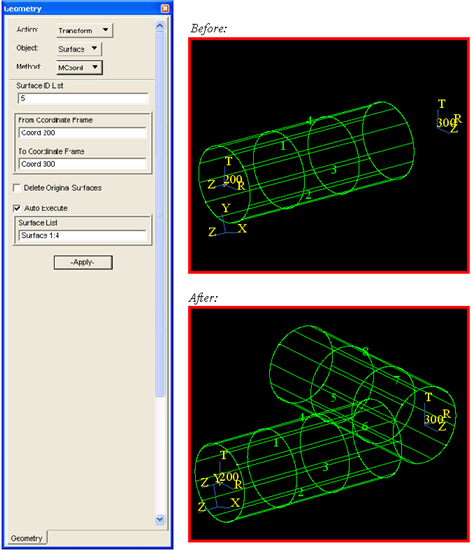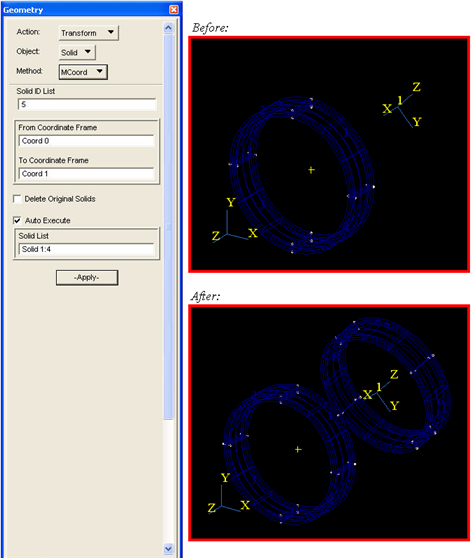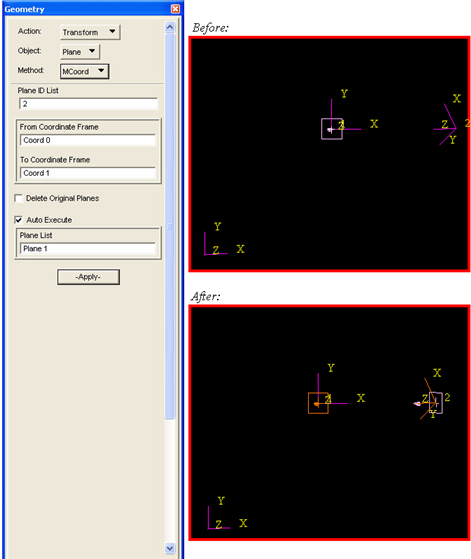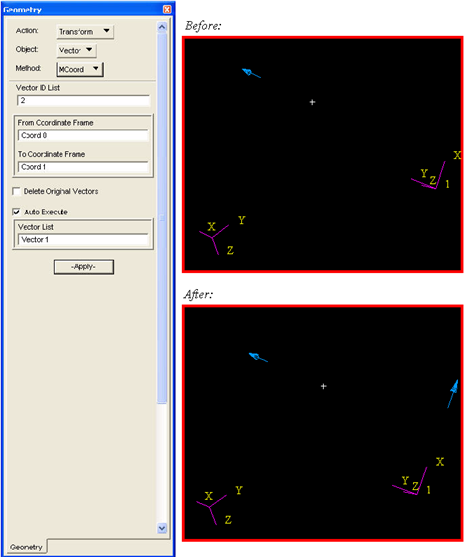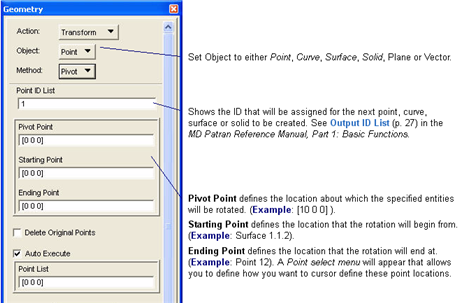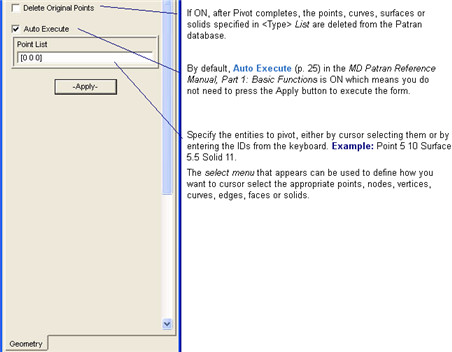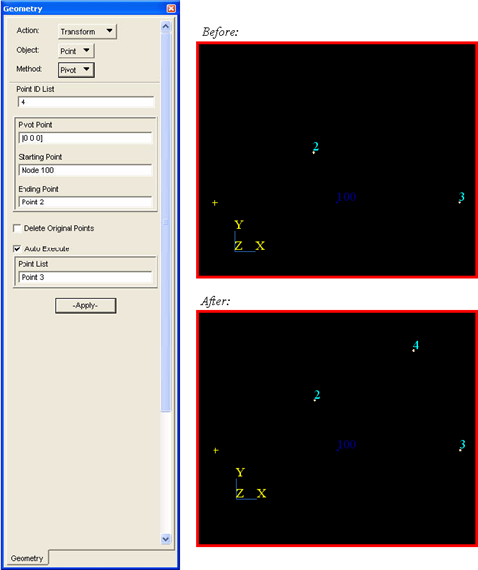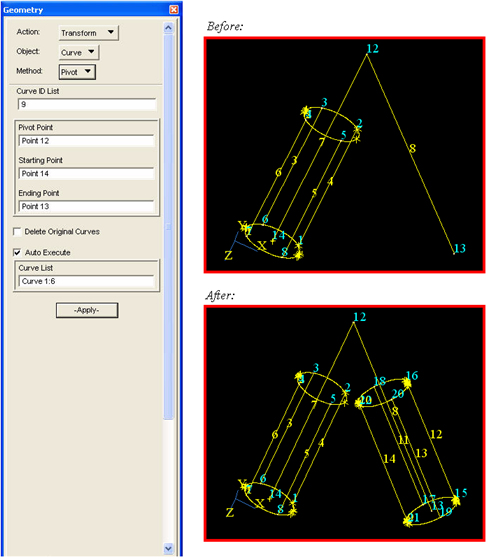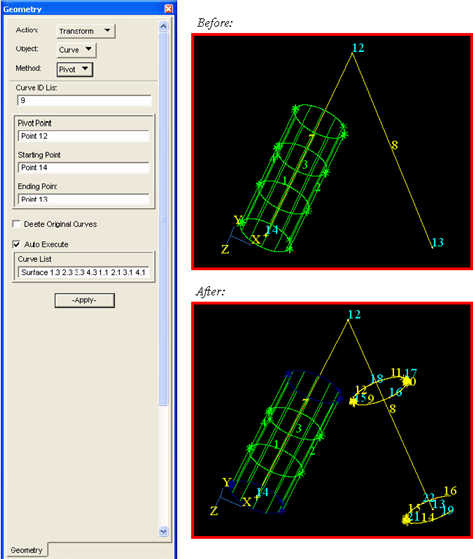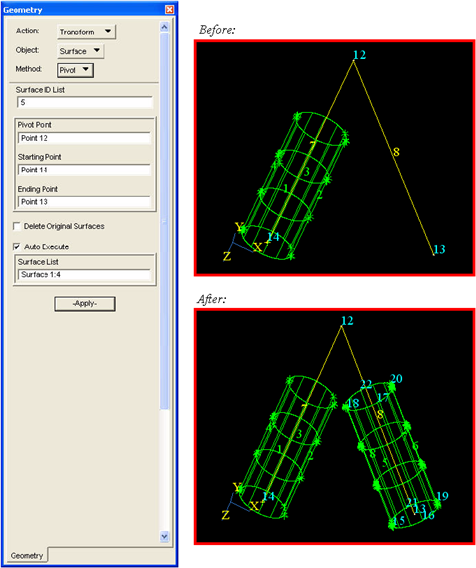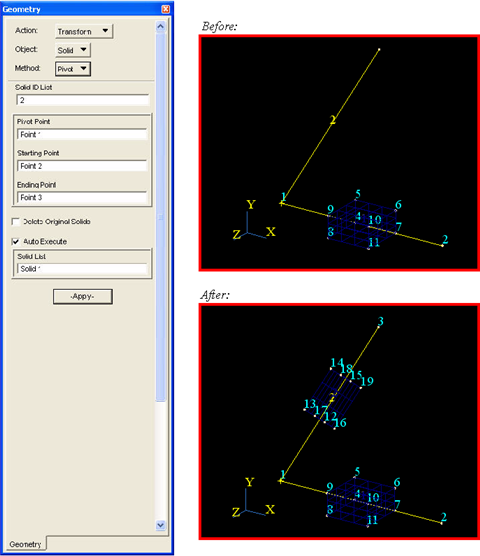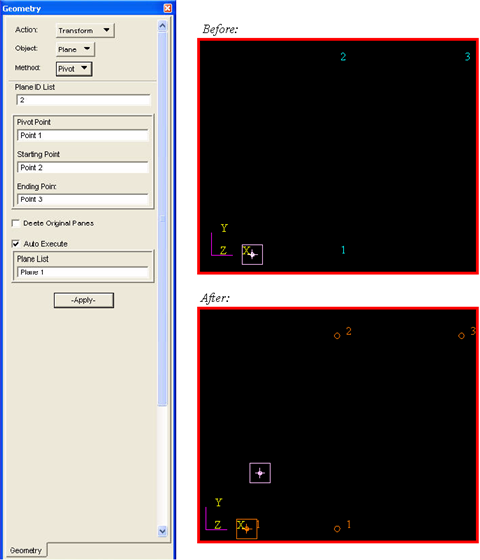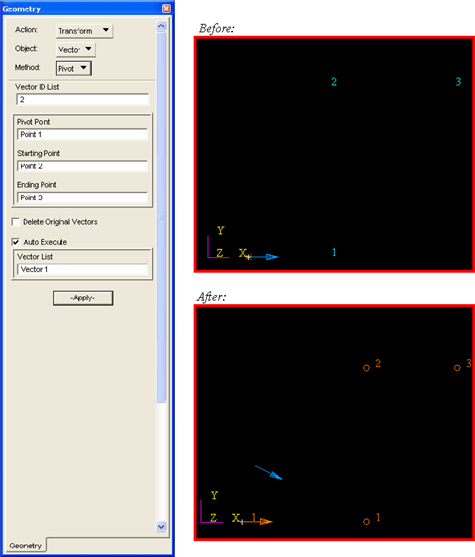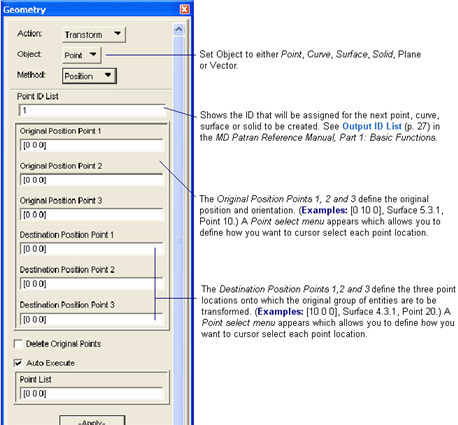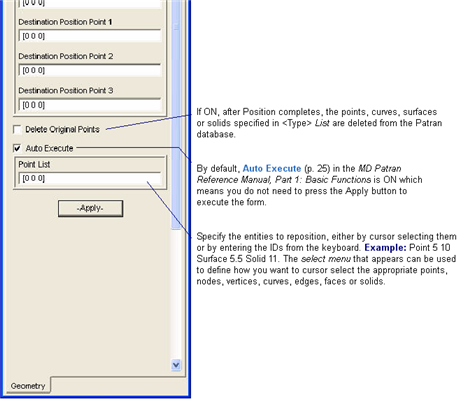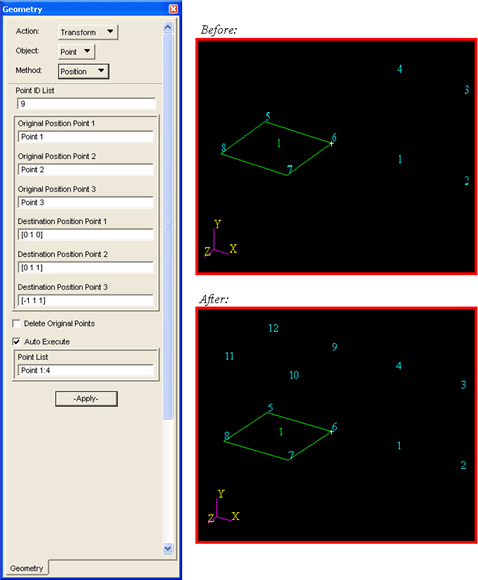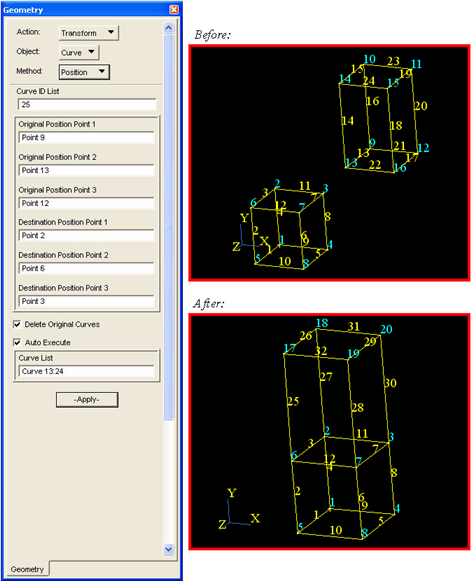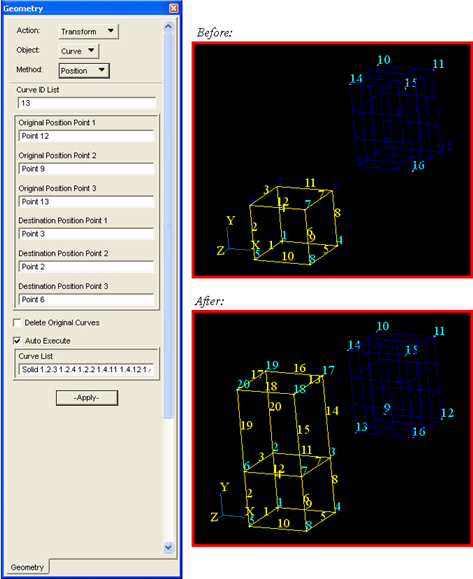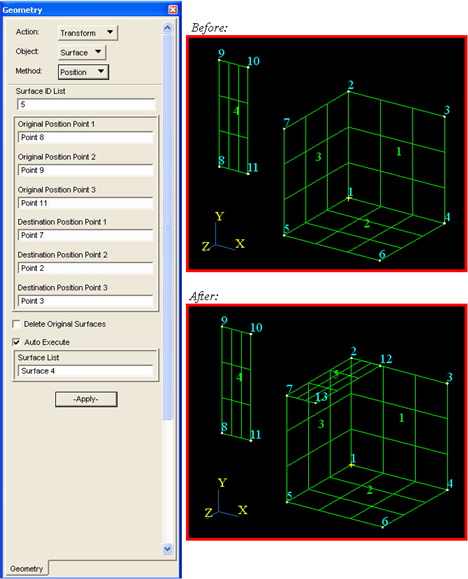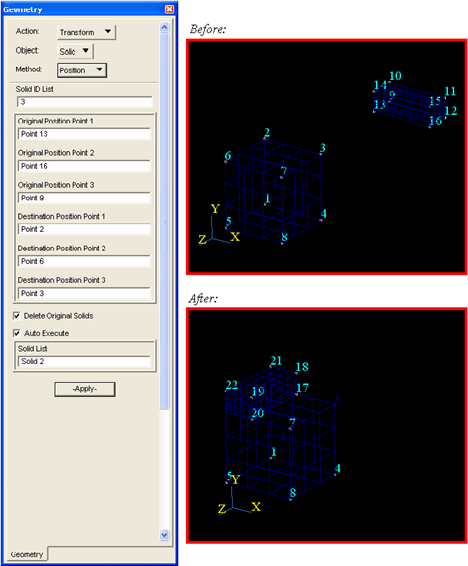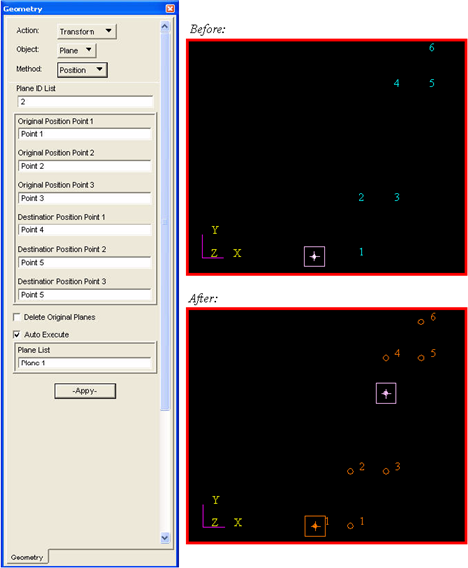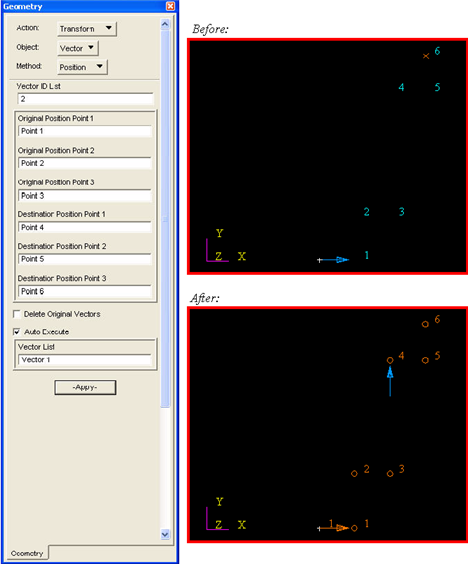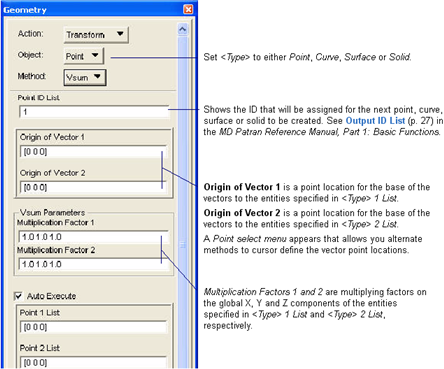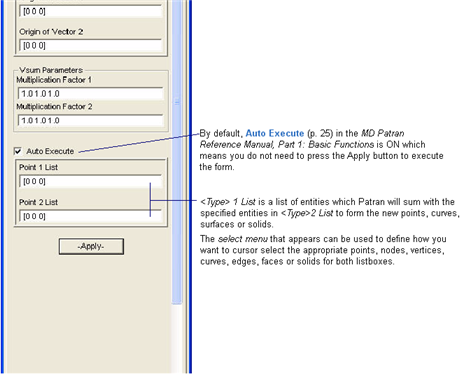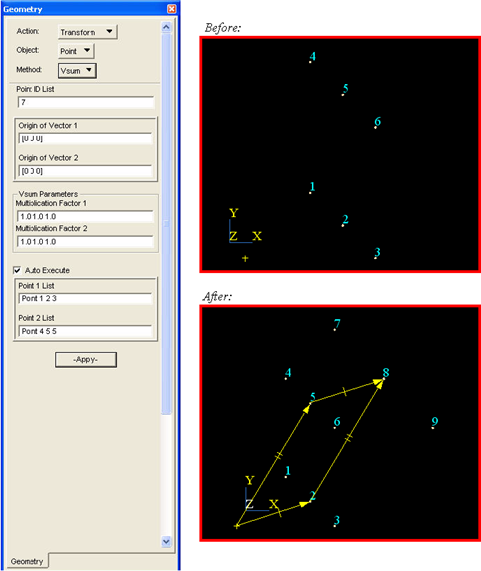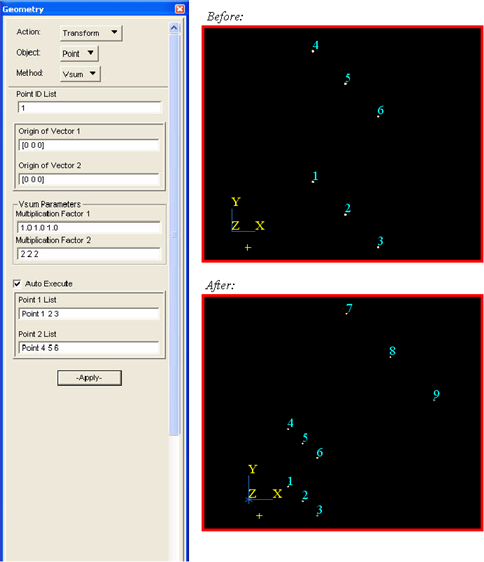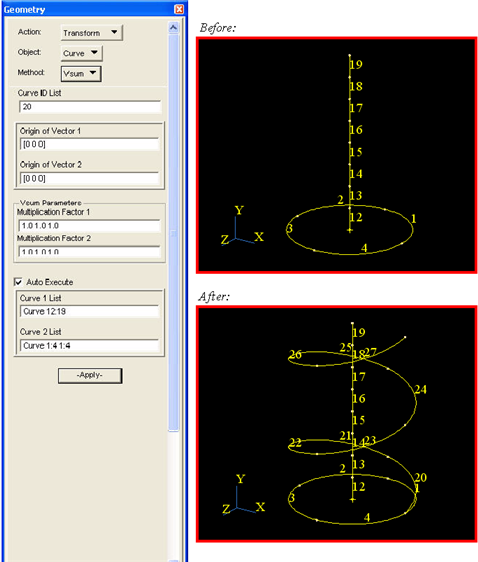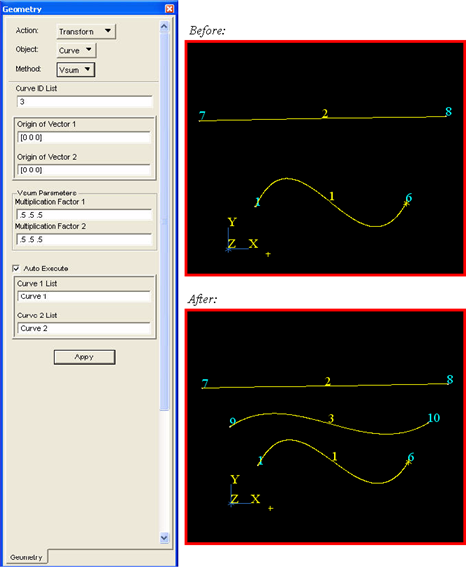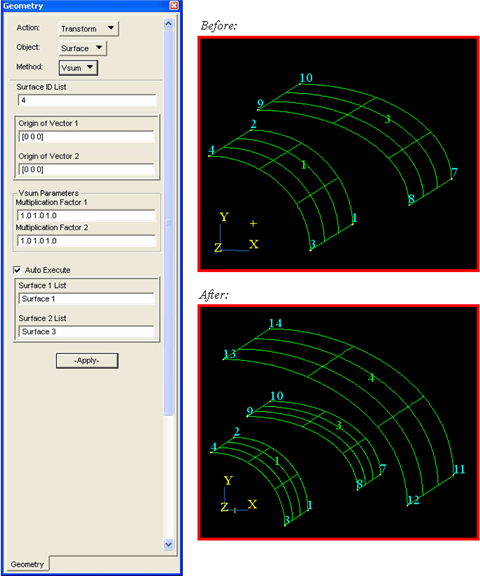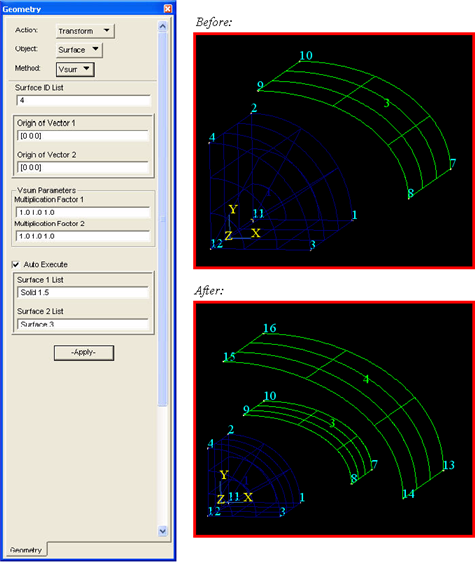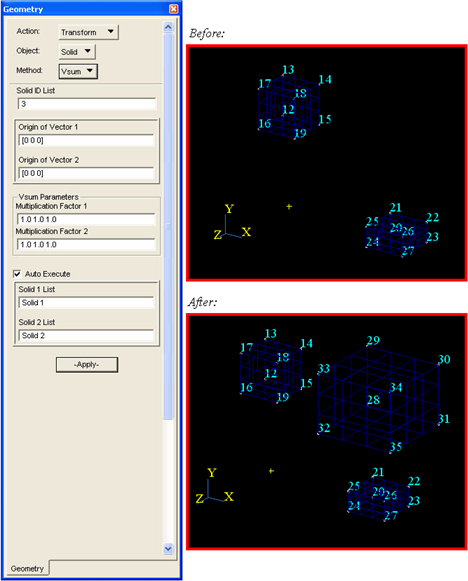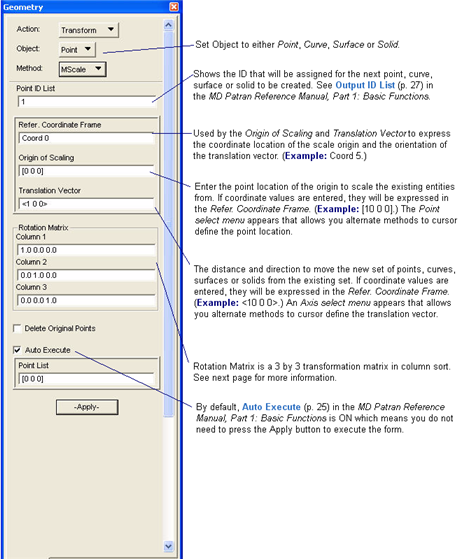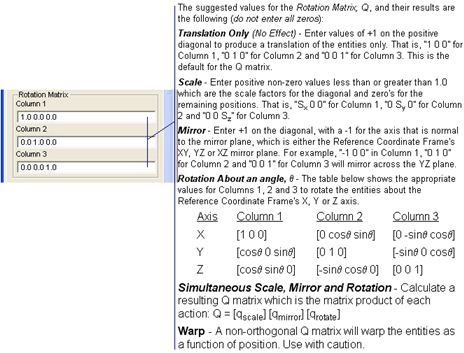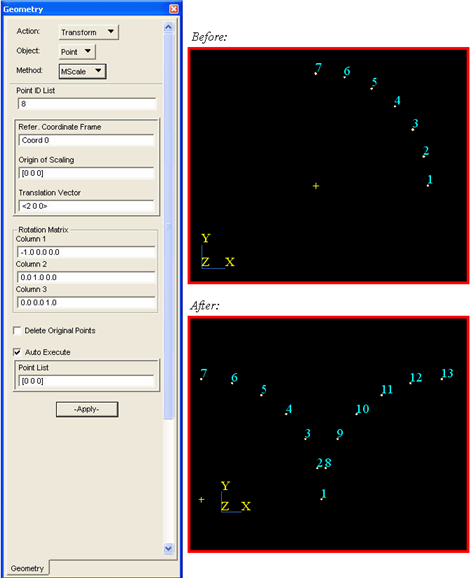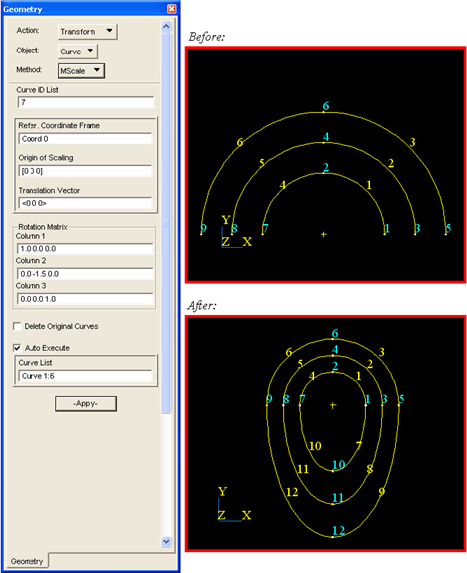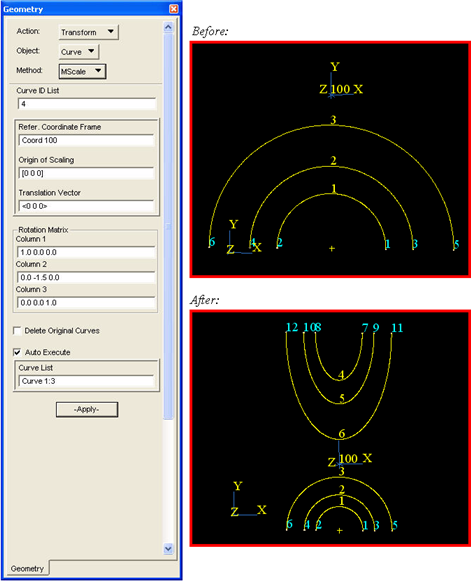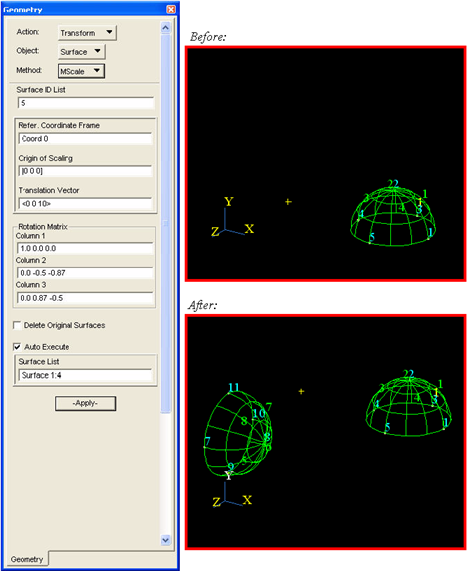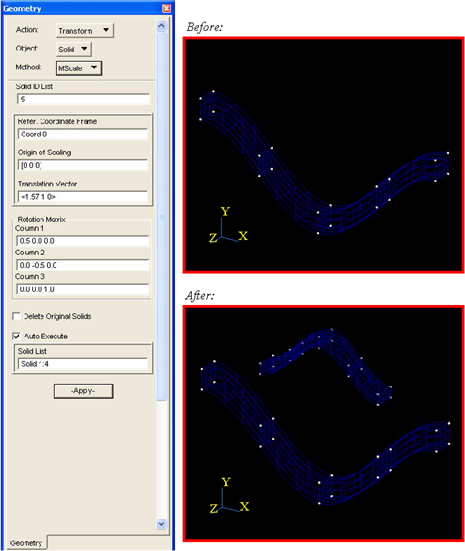XXXXXXXXXXXXXXXXXXXXXXXXXXXXXXXXXXXXXXXXXXXXXXXXXXXXXXXXXXXXXXXXXXXXXXXXXXXXXXXXXXXXXXXXXXXXXXXXXXXXXXXXXXXXXXXXXXXXXXXXXXXXXXXXXXXXXXXXXXXXXXXXXXXXXXXX''"> Transforming Points, Curves, Surfaces, Solids, Planes and Vectors
Translating Points, Curves, Surfaces, Solids, Planes and Vectors
The Translate method creates a set of points, curves, surfaces, solids planes or vectors which are successively offset from each other by a defined Translation Vector <dx dy dz>. Points can be translated from points, vertices or nodes. Curves can be translated from curves or edges. Surfaces can be translated from surfaces or solid faces. Solids are translated from solids.
Tip: More Help:
Translating Points Radially
Creates Points 8 through 14 by translating Points 1 through 7, three units radially outward within the cylindrical coordinate frame, Coord 100. Notice that Curvilinear in Refer. CF is pressed.
Translating Points
This example is the same as the previous example, except Cartesian in Refer. CF is pressed instead of Curvilinear in Refer. CF.
Translating Curves
Creates Curves 2 through 6 by translating Curves 1 three times - two units in the X direction and one unit in the Y direction within the global rectangular coordinate frame, Coord 0.
Translating Curves Radially
Translates Curve 1 three times and radially one unit outward within the cylindrical coordinate frame, Coord 100. Notice that Curvilinear in Refer. CF is pressed.
Translating Edges
Creates Curve 2 by translating the outside edge of Surface 1, two units radially outward within cylindrical coordinate frame, Coord 100.
Translating Surfaces
Creates Surfaces 2 and 3 by translating Surface 1 two times - one unit in the X direction and two units in the Y direction within the rectangular coordinate frame, Coord 10.
Translating Surfaces Radially
Creates Surfaces 2 through 4 by translating Surface 1 three times and one unit radially outward within the cylindrical coordinate frame, Coord 100.
Translating Solid Faces
Creates Surfaces 1 through 4 by translating the top faces of Solids 1 through 4, 0.5 units radially outward within the spherical coordinate frame, Coord 20. Notice that Curvilinear in Refer. CF is pressed.
Translating Solids
Translates Solids 1 through 4, 1.5 units in the X direction and 1.5 units in the Y direction, within the global rectangular coordinate frame, Coord 0. Notice that Delete Original Solids is pressed and Solids 1:4 are deleted.
Translating Solids
Creates Solid 2 by translating Solid 1, 90 degrees within the cylindrical coordinate frame, Coord 1. Notice that Curvilinear in Refer. CF is pressed.
Translating Planes
Translates Plane 1 2 units in the Z direction with the global rectangular coordinate frame, Coord 0. Note that Delete Original Plane is not pressed and Plane 1 is kept.
Translating Vectors
Translates Vector 1 2 units in the X direction with the global rectangular coordinate frame, Coord 0. Notice that Delete Original Vector is not pressed and Vector 1 is kept.
Rotating Points, Curves, Surfaces, Solids, Planes and Vectors
Creates a set of points, curves, surfaces, solids, planes or vectors by a rigid body rotation about a defined axis from an existing set of entities. Points can be rotated from other points, vertices or nodes. Curves can be rotated from other curves or edges. Surfaces can be rotated from other surfaces or solid faces. Solids are rotated from other solids.
Tip: More Help:
Rotating Points and Nodes
Creates Points 7 through 14 from Point 1 and Node 10 by rotating them six times, 30 degrees about the global rectangular coordinate frame’s Z axis, Coord 0.3, with an offset angle of 60 degrees. (Coord 0.3 can be cursor defined by using the Axis select menu icon listed below and cursor selecting Coord 0.)
Rotating Curves
Creates Curves 2 through 7 by rotating Curve 1 six times, 30 degrees about the axis defined by {[0 0 0][0 0 1]}. Notice that the axis definition is equivalent to Coord 0.3 from the previous example.
Rotating From An Edge
This example is the same as the previous example, except that Curves 1 through 6 are rotated from an edge of Surface 1.
Rotating Surfaces
Creates Surfaces 4 through 18 by rotating from Surfaces 1, 2 and 3, five times, 30 degrees each about the axis defined by Points 4 and 1. The axis is defined by cursor selecting the points using the Axis select menu icon listed below.
Rotating From Solid Faces
This example is the same as the previous example, except that Surfaces 1 through 16 are rotated from the outside faces of Solid 1.
Rotating Solids
Creates Solids 2 through 4 by rotating from Solid 1, three times, 90 degrees each about the global Z axis, Coord 0.3. Coord 0.3 is cursor defined by using the Axis select menu icon listed below.
Rotating Planes
Rotates Plane 1 90 degrees around the Y Axis in the global rectangular coordinate frame, Coord 0. Notice that Delete Original Plane is not pressed and Plane 1 is kept.
Rotating Vectors
Rotates Vector 1 90 degrees around the Z Axis in the global rectangular coordinate frame, Coord 0. Notice that Delete Original Vector is not pressed and Vector 1 is kept.
Scaling Points, Curves, Surfaces, Solids and Vectors
The Scale method creates a set of points, curves, surfaces, solids or vectors by scaling an existing set of entities. Points can be scaled from other points, vertices or nodes. Curves can be scaled from other curves or edges. Surfaces can be scaled from other surfaces or solid faces. Solids are scaled from other solids.
Tip: More Help:
Scaling Points and Nodes
Creates Points 6 through 9 by scaling them from Points 1, 2, 5 and Node 100 two times along the global X and Y axes, with Point 4 as the origin of scaling.
Scaling Points Radially
Creates Points 25 through 44 by scaling them from the points on the outside edge of Surfaces 1 through 4, two times radially within the cylindrical coordinate frame, Coord 100. Notice that Curvilinear in Refer. CF and Delete Original Points are pressed.
Scaling Curves
Creates Curve 2 by scaling them from Curve 1, 1.5 times along the X axis of rectangular coordinate frame, Coord 20. Notice that Delete Original Curves is pressed and Curve 1 is deleted.
Scaling From An Edge
Creates Curves 1 through 4 by scaling them from the outside edges of Surfaces 1 through 4, 1.5 times radially outward within the cylindrical coordinate frame, Coord 20. Notice that Curvilinear in Refer. CF is pressed.
Scaling Surfaces
Creates Surfaces 5 through 8 by scaling Surfaces 1 through 4 1.5 times along the radial axis of cylindrical coordinate frame, Coord 20. Notice that Cartesian in Refer. CF and Delete Original Surfaces are pressed.
Scaling Surfaces Radially
This example is the same as the previous example, except that Curvilinear in Refer. CF is selected instead of Cartesian in Refer. CF.
Scaling From Solid Faces
Creates Surface 1 by scaling it from the top face of Solid 1, 1.5 times in the X, Y and Z directions of the global rectangular coordinate frame, Coord 0.
Scaling From Solids
Creates Solids 5 through 8 by scaling them from Solids 1 through 4, two times in the X and Y directions of the global rectangular coordinate frame, Coord 0.
Scaling From Vectors
Scales Vector 1 with a scale factor of 2 in the X direction in the global rectangular coordinate frame, Coord 0. Notice that Delete Original Vector is not pressed and Vector 1 is kept.
Mirroring Points, Curves, Surfaces, Solids, Planes and Vectors
Creates a set of points, curves, surfaces, solids, planes or vectors by a defined mirror plane of an existing set of entities. Points can be mirrored from other points, nodes or vertices. Curves can be mirrored from other curves or edges. Surfaces can be mirrored from other surfaces or solid faces. Solids are mirrored from other solids.
Tip: More Help:
Mirroring Points and Nodes
Creates Points 7 through 12 by mirroring them from Points 1 through 6 and Node 100, about the mirror plane whose normal is the global X axis, Coord 0.1. Coord 0.1 can be cursor defined by using the Axis select menu icon listed below.
Mirroring Curves
Creates Curves 3 and 4 by mirroring them from Curves 1 and 2 about the plane whose normal is the global Y axis, Coord 0.2, and with an offset of Y=-1.
Mirroring From Edges
Creates Curves 1 through 8 by mirroring them from the inner and outer edges of Surfaces 5 through 8 about the plane whose normal is rectangular coordinate frame 1’s Y axis, Coord 1.2.
Mirroring Surfaces
This example is similar to the previous example, except that Surfaces 1 through 4 are mirrored from Surfaces 5 through 8.
Mirroring Solids
Creates Solid 2 by mirroring Solid 1 about the plane whose normal is defined by {[0 0 0][1 0 0]}. Notice that the mirror plane normal definition is the same as entering the global X axis, Coord 0.1.
Mirroring Planes
Mirrors Plane 1 against the X-Y plane and with an offset of 1 unit in the Z direction in the global rectangular coordinate frame, Coord 0. Notice that Delete Original Plane is not pressed and Plane 1 is kept. Also, the Reverse Plane is not pressed and Plane 2 is not reversed.
Mirroring Vectors
Mirrors Vector 1 against the X-Y plane and with an offset of 1 unit in the Z direction in the global rectangular coordinate frame, Coord 0. Notice that Delete Original Vector is not pressed and Vector 1 is kept. Also, the Reverse Vector is not pressed and Vector 2 is not reversed.
Moving Points, Curves, Surfaces, Solids, Planes and Vectors by Coordinate Frame Reference (MCoord Method)
Translates and rotates a new set of points, curves, surfaces, solids, planes or vectors from an existing set of entities by referencing coordinate frames. The new entities’ local position with respect to the To Coordinate Frame is the same as the local position of the original entities with respect to the From Coordinate Frame. Points can be moved from other points, nodes or vertices. Curves can be moved from other curves or edges. Surfaces can be moved from other surfaces or solid faces. Solids are moved from other solids.
Tip: More Help:
Moving Points and Nodes
Creates Points 7 through 12 from Points 1, 3, 4, 5, 6 and Node 100 by moving them from the global rectangular coordinate frame, Coord 0, to the rectangular coordinate frame, Coord 100.
Moving Curves
Creates Curves 7 through 12 by moving Curves 1 through 6 from cylindrical coordinate frame, Coord 200 to cylindrical coordinate frame, Coord 300.
Moving From Edges
This example is similar to the previous example, except that Curves 1 through 8 are moved from the outside edges of Surfaces 1 through 4, from Coord 200 to Coord 300.
Moving Surfaces
Creates Surfaces 5 through 8 by moving from Surfaces 1 through 4 from cylindrical coordinate frame, Coord 200, to cylindrical coordinate frame, Coord 300.
Moving Solids
Creates Solids 5 through 8 by moving Solids 1 through 4 from the global coordinate frame, Coord 0, to the rectangular coordinate frame, Coord 1.
Moving Planes
Moves Plane 1 from the rectangular coordinate frame, Coord 0, to the rectangular coordinate frame, Coord 1. Notice that Delete Original Plane is not pressed and Plane 1 is kept.
Moving Vectors
Moves Vector 1 from the rectangular coordinate frame, Coord 0, to the rectangular coordinate frame, Coord 1. Notice that Delete Original Vector is not pressed and Vector 1 is kept.
Pivoting Points, Curves, Surfaces, Solids, Planes and Vectors
Creates points, curves, surfaces, solids, planes and vectors by using a planar rotation defined by a specified Pivot Point about which the entity will be rotated, and a Starting Point and Ending Point for the rotation. Points can be pivoted from other points, nodes or vertices. Curves can be pivoted from other curves or edges. Surfaces can be pivoted from other surfaces or solid faces. Solids are pivoted from other solids.
Tip: More Help:
Pivoting Points
Creates Point 4 from Point 3 by pivoting at the global origin, [0 0 0], from Node 100 to Point 2.
Pivoting Curves
Creates Curves 9 through 15 from Curves 1 through 6 by pivoting them at Point 12, from Point 14 to Point 13. (Curves 7 and 8 are for illustration and are not used for the pivot.)
Pivoting From Edges
Creates Curves 9 through 16 by pivoting from the outside edges of Surfaces 1 through 4, at Point 12, from Point 14 to Point 13. Curves 7 and 8 are for illustration and are not used for the pivot.
Pivoting Surfaces
This example is similar to the previous example, except that Surfaces 1 through 4 are pivoted to create Surfaces 5 through 8. Curves 7 and 8 are for illustration and are not used for the pivot.
Pivoting Solids
Creates Solid 2 by pivoting from Solid 1 at Point 1, from Point 2 to Point 3. Curves 1 and 2 are for illustration and are not used for the pivot.
Pivoting Planes
Pivots Plane 1 using the 3 pivoting points, Point 1 through 3. Notice that Delete Original Plane is not pressed and Plane 1 is kept.
Pivoting Vectors
Pivots Vector 1 using the 3 pivoting points, Point 1 through 3. Notice that Delete Original Vector is not pressed and Vector 1 is kept.
Positioning Points, Curves, Surfaces, Solids, Planes and Vectors
Creates points, curves, surfaces, solids, planes and vectors by translating and rotating an existing set of entities using a transformation defined by three original point locations to three destination point locations.
The original points and destination points need not match exactly; however, if either the original point locations or the destination point locations lie in a straight line, the transformation cannot be performed. Points can be repositioned from other points, nodes or vertices. Curves can be repositioned from other curves or edges. Surfaces can be repositioned from other surfaces or solid faces. Solids are repositioned from other solids.
Tip: More Help:
• Select Menu (p. 33) in the MD Patran Reference Manual, Part 1: Basic Functions
• Coordinate Frame Definitions (p. 60)
Positioning Points
Creates Points 9 through 12 from Points 1through 4 by repositioning them based on the original and destination point locations listed on the form.
Positioning Curves
Creates Curves 25 through 32 by repositioning Curves 13 through 24 from Points 9, 13 and 12, to destination Points 2, 6 and 3. Notice that Delete Original Curves is pressed and Curves 13 through 24 are deleted.
Positioning From Edges
This example is similar to the previous example, except that the edges of Solid 1 are repositioned to the new location to create Curves 13 through 20.
Positioning Surfaces
Creates Surface 5 from Surface 4 by positioning it from Points 8, 9 and 11 to the destination Points 7, 2 and 3.
Positioning Solids
Creates Solid 3 by repositioning it from Solid 2, based on the original and destination points listed on the form. Notice that Delete Original Solids is pressed and Solid 2 is deleted.
Positioning Planes
Positions Plane 1 from where defined by the position Point 1 through 3, to where defined by the position Point 4 through 6. Notice that Delete Original Plane is not pressed and Plane 1 is kept.
Positioning Vectors
Positions Vector 1 from where defined by the position Point 1 through 3, to where defined by the position Point 4 through 6. Notice that Delete Original Vector is not pressed and Vector 1 is kept.
Vector Summing (VSum) Points, Curves, Surfaces and Solids
Creates points, curves, surfaces or solids by performing a vector sum of the coordinate locations of two sets of existing entities to form one set of new entities. Points can be created from the summation of other points, nodes or vertices. Curves can be created from the summation of other curves or edges. Surfaces can be created from the summation of other surfaces or solid faces. Solids are created from the summation of other solids.
Tip: More Help:
Vector Summing Points
Creates Points 7, 8 and 9 by summing the vectors drawn from the origin, [0 0 0], to Points 1 and 4, 2 and 5 and 3 and 6. The “After” picture below has the vectors drawn to Points 2 and 5 to show how Point 8 was created.
Vector Summing Points
This example is the same as the previous example, except that a Multiplication Factor 2 is increased from “1 1 1” to “2 2 2”.
Vector Summing Curves
Creates Curves 20 through 27 which are summed between Curves 12 through 19 and Curves 1 through 4. Notice that in order to create the spiral, Curve 1:4 must be entered twice in the Curve 2 List to match the eight curves listed in the Curve 1 List.
Vector Summing Curves
Creates Curve 3 by summing Curves 1 and 2. Notice that the multiplication factors of “.5 .5 .5” are entered for both Multiplication Factors 1 and 2 and Curve 3 becomes the “average” of Curves 1 and 2 in length and in curvature.
Vector Summing Surfaces
This example creates Surface 4 from vector summing the coordinate locations of Surfaces 1 and 3.
Vector Summing With Solid Faces
This example is similar to the previous example, except that Surface 4 is created by vector summing the coordinate locations of the outside face of Solid 1 and Surface 3.
Vector Summing Solids
Creates Solid 3 by vector summing the coordinate locations of Solids 1 and 2.
Moving and Scaling (MScale) Points, Curves, Surfaces and Solids
Creates a set of points, curves, surfaces and solids by simultaneously moving, scaling, rotating and/or warping an existing set of entities. Points can be moved and scaled from other points, nodes or vertices. Curves can be moved and scaled from other curves or edges. Surfaces can be moved and scaled from other surfaces or solid faces. Solids are moved and scaled from other solids.
Tip: More Help:
Translating and Mirroring Points
Creates Points 8 through 13 by simultaneously translating and mirroring Points 1 though 7, two units in the global X direction and mirroring about the global YZ plane.
Mirroring and Scaling Curves
Creates Curves 7 through 12 by simultaneously scaling and mirroring Curves 1 through 6. The curves are scaled two times in the global Y direction and they are mirrored about the global XZ plane.
Mirroring and Scaling Curves
This example is similar to the previous example, except that the curves are mirrored and scaled within the rectangular coordinate frame, Coord 100.
Translating and Rotating Surfaces
Creates Surfaces 5 through 8 from Surfaces 1 through 4 by translating them 10 units in the global Z direction and rotating them -120 degrees about the global X axis.
Translating, Mirroring and Scaling Solids
This example simultaneously translates, mirrors and scales Solids 5 through 8 from Solids 1 through 4, by translating them 1.57 units in the global X direction and 1.0 unit in the global Y direction; mirroring them about the global XZ plane; and scaling them .5 in the X direction and .5 in the Y direction.
